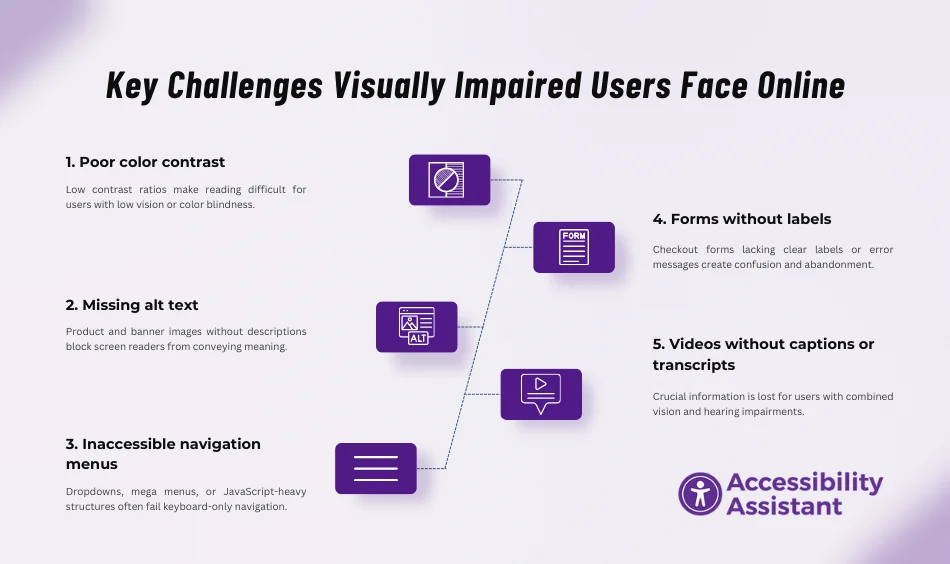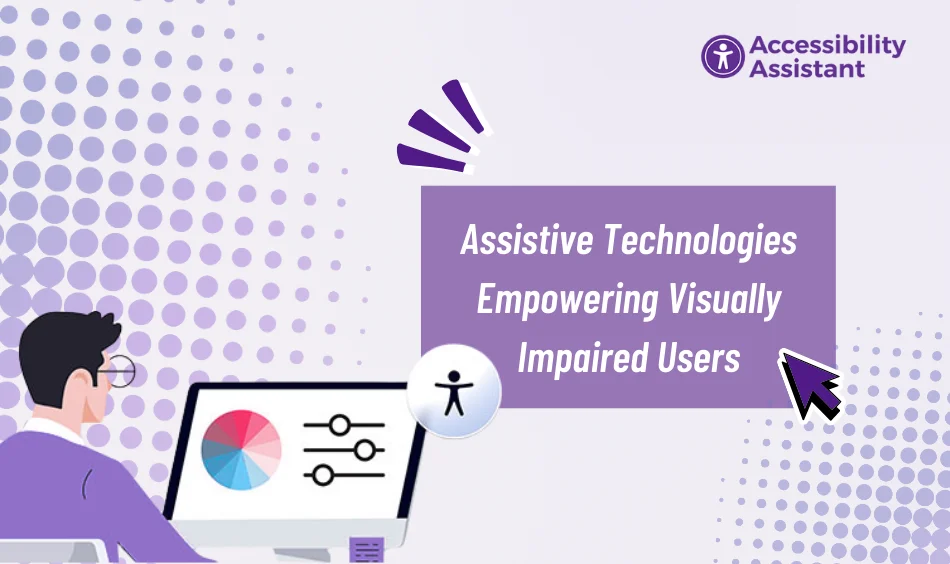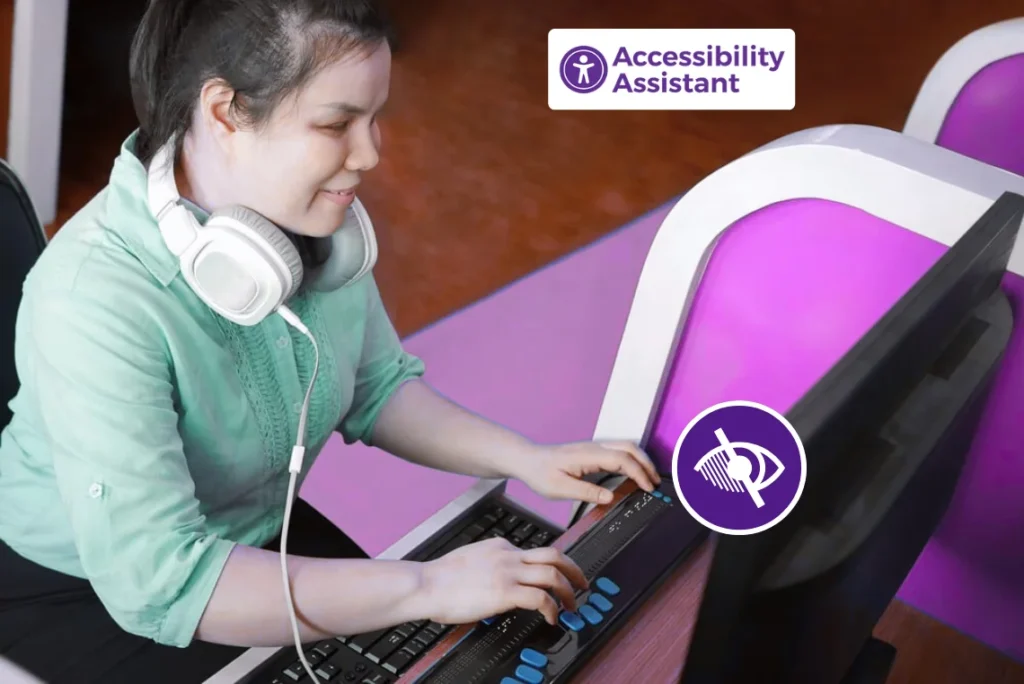Introduction
Web accessibility for visually impaired users is essential in today’s digital world, where the internet powers shopping, learning, and communication. Yet millions still face barriers online. The World Health Organization reports that over 2.2 billion people globally live with vision impairment, from low vision to complete blindness.
This is where web accessibility for visually impaired users is available. By following accessibility tips, groups could make their websites usable for every person, whilst also meeting ADA and WCAG compliance requirements. Beyond being a legal responsibility, accessibility improves search engine optimization performance, users’ trust, and conversions.
In this guide, we’ll cover:
- Who are visually impaired users, and what challenges do they face?
- Assistive technologies like screen readers and magnifiers.
- Design and development best practices for accessibility.
- Top tools to help achieve compliance.
- How solutions like Accessibility Assistant simplify the process.
Understanding Web Accessibility for Visually Impaired Users
Web accessibility for visually impaired users includes developing websites that humans with blindness, low vision, or color blindness can apprehend, navigate, and engage with.
It goes beyond adding alt text or resizing font. Real accessibility involves designing real human reviews in the beginning with help features, including display readers, magnification, and key navigation, and guarantees that no user is left behind.
Types of Visual Impairments Addressed by Accessibility
- Blindness: Full vision loss requiring screen readers (JAWS, NVDA, VoiceOver) or Braille displays.
- Low Vision: Users may rely on magnification tools, text zoom, or high-contrast design.
- Color Blindness: Requires thoughtful use of contrast, patterns, and non-color indicators to convey meaning.
Latest Data (WHO & CDC):
- Over 2.2 billion people globally live with vision impairment.
- In the U.S. alone, 12 million adults over age 40 report some form of visual disability.
- e-commerce is one of the most impacted industries, with lawsuits citing inaccessible checkout forms, missing alt text, and low-contrast designs.
When websites don’t meet WCAG 2.2 accessibility standards, visually impaired users are excluded from essential actions like shopping, booking services, and accessing information, resulting in lost revenue and legal risks for businesses.
Key Challenges Visually Impaired Users Face Online
Despite improvements in digital accessibility, many websites remain hard to navigate for humans with imaginative and vision impairments. These challenges now not only exclude users but also expose organizations to misplaced sales and ADA compliance risks.

Common Barriers
- Poor color contrast: Low contrast ratios make reading difficult for users with low vision or color blindness.
- Missing alt text: Product and banner images without descriptions block screen readers from conveying meaning.
- Inaccessible navigation menus: Dropdowns, mega menus, or JavaScript-heavy structures often fail keyboard-only navigation.
- Forms without labels: Checkout forms lacking clear labels or error messages create confusion and abandonment.
- Videos without captions or transcripts: Crucial information is lost for users with combined vision and hearing impairments.
These problems highlight the urgent need for accessible layout and compliance with WCAG 2.2 requirements, making sure that visually impaired customers can browse, store, and engage online without boundaries.
Accessibility Guidelines and Standards for Visually Impaired Users
Ensuring web accessibility for visually impaired users isn’t optional; it’s a legal obligation and business necessity. Multiple frameworks define how businesses should design digital platforms to remove barriers.
Ensuring web accessibility for visually impaired users isn’t non-obligatory; it’s a legal responsibility and business necessity. Multiple frameworks define how businesses need to lay out virtual structures to overcome boundaries.
ADA Compliance for eCommerce
The Americans with Disabilities Act (ADA) requires businesses within the U.S. To provide identical access to products and services, such as e-commerce websites and mobile apps.
- Failure to comply can lead to lawsuits, financial penalties, and reputational damage.
- Over 4,000 ADA-related lawsuits were filed, with 77% targeting e-commerce websites.
- Courts increasingly use WCAG 2.2 AA as the benchmark for ADA digital compliance.
WCAG (Web Content Accessibility Guidelines)
WCAG is the worldwide gold standard for digital accessibility. The latest version, WCAG 2.2, introduces stricter standards for usability, especially for visually impaired customers.
Key requirements include:
- Providing alt text for all images and non-text content.
- Maintaining contrast ratios of at least 4.5:1 for body text.
- Designing for keyboard-only navigation and logical tab orders.
- Offering clear heading structures for screen reader navigation.
- Supporting text scaling and zoom up to 200% without breaking layouts.
Section 508 (U.S. Federal Websites)
While geared toward government systems, Section 508 requirements are extensively adopted through non-public organizations to illustrate accessibility commitment.
- They align closely with WCAG 2.0 and 2.1 requirements.
- Many federal contractors must meet Section 508 compliance, even for commercial projects.
Following WCAG 2.2 AA requirements no longer best meets ADA requirements, but also guarantees a higher, more inclusive consumer experience for visually impaired users. Proactive compliance reduces legal risks and expands your market reach.
Assistive Technologies Empowering Visually Impaired Users
For millions of visually impaired users, assistive technologies are the bridge to gaining access to digital content. Websites that fail to guide those tools to a widespread target audience face legal non-compliance.

Screen Readers
Programs like JAWS, NVDA, and VoiceOver convert on-screen text into speech or Braille.
- They rely on proper semantic HTML and alt text to interpret web content correctly.
- According to a 2024 WebAIM survey, 89% of blind users rely on screen readers daily.
Screen Magnifiers
Tools such as ZoomText or Windows Magnifier enlarge sections of the screen.
- Essential for users with low vision or age-related vision loss.
- Websites must allow text resizing up to 200% without breaking the design.
Keyboard Navigation
Many visually impaired users navigate without a mouse, relying solely on the Tab, Shift+Tab, and arrow keys.
- Poorly designed menus and missing focus indicators can block access to vital features like checkout.
Voice Commands
Tools like Dragon NaturallySpeaking let users browse, fill forms, and shop online hands-free.
- Increasingly popular for those with combined vision and motor impairments.
Braille Displays
Refreshable Braille devices convert on-screen content into Braille.
- Only effective if content is coded correctly with labels, headings, and structure.
If your website doesn’t support these assistive technologies, you’re excluding millions of potential customers and increasing your ADA compliance risks.
Practical Steps to Improve eCommerce Accessibility for Visually Impaired Users
Improving accessibility for visually impaired users requires both technical fixes and ongoing monitoring. These steps align with WCAG 2.2 AA guidelines and can be streamlined using tools like the Accessibility Assistant App available for Shopify, WordPress, Wix, and Other Platforms.
1. Add Descriptive Alt Text for Images
- Explain the context of each image instead of just naming the product.
- Example: “Red cotton t-shirt with white front logo.”
- Accessibility Assistant can auto-detect missing alt text and suggest fixes.
2. Maintain Proper Color Contrast
- WCAG requires a minimum contrast ratio of 4.5:1 for normal text and 3:1 for large text.
- Run automated contrast scans on banners, buttons, and checkout forms.
3. Ensure Keyboard-Only Navigation
- Menus, product filters, and checkout must be navigable with Tab and arrow keys.
- Add visible focus indicators so users know their location on the page.
4. Provide Clear Headings and Structure
- Use H1 for titles, H2 for sections, and H3 for sub-sections consistently.
- Accessibility Assistant highlights heading hierarchy issues in real time.
5. Use ARIA Landmarks and Semantic HTML
- Add ARIA roles, such as <nav role=”navigation”> for menus or <form role=”form”> for checkout forms.
- This helps screen readers accurately interpret the content structure.
6. Make Forms Accessible
- Label all form inputs clearly.
- Provide text-based error messages, not just color cues.
- Allow users to review and correct mistakes before submission.
7. Allow Text Scaling
- Websites must support 200% zoom without breaking the design.
- Test across devices to ensure no overlapping content or cut-off text.
8. Provide Captions and Transcripts
- Videos must have closed captions.
- Audio-only content should include text transcripts.
- Accessibility Assistant reminds content creators of missing captions.
Pro Tip: Accessibility is not a one-time task. Pair these steps with real-time monitoring to catch new issues as your site evolves. Tools like Accessibility Assistant simplify compliance, making it easy for businesses to maintain accessibility across updates.
Top Tools and Solutions to Improve Web Accessibility
The demand for available websites is at an all-time high, with WCAG 2.2 updates and increasing ADA complaints pushing businesses to act. Choosing the right app can mean the distinction between meeting compliance readily or dealing with pricey remediation later.
The table below highlights the main web accessibility equipment available, its high-quality use instances, and key capabilities. From computerized tests to real-time monitoring, these answers assist businesses of all sizes in creating inclusive digital reports.
| Tool | Best For | Key Features |
| Accessibility Assistant | Shopify, WordPress, Wix websites | Automated fixes, WCAG compliance, real-time monitoring |
| WAVE | Quick testing | Browser extension, inline feedback |
| axe DevTools | Developer-focused fixes | Code-level testing, WCAG checks |
| Siteimprove | Enterprise & universities | Accessibility + SEO insights |
| EqualWeb | AI remediation | Widget customization, multi-language support |
Note: While some tools focus on testing and reporting, others like Accessibility Assistant go further by providing automated remediation, cross-platform integration, and ongoing monitoring—making them a top choice for businesses aiming for fast and effective compliance.
Benefits of Web Accessibility for Visually Impaired Users
- Legal Protection: Avoid ADA lawsuits and penalties.
- Expanded Reach: Access to millions of visually impaired customers.
- SEO Gains: Improved structure, alt text, and metadata boost rankings.
- Improved UX: Easier navigation for all users, including mobile.
- Brand Trust: Inclusive design strengthens reputation and loyalty.
Common Accessibility Mistakes to Avoid
- Using color alone to indicate required fields.
- Forgetting alt text for banners and product images.
- Ignoring mobile accessibility.
- Relying only on automated scans (manual checks are critical).
- Not updating accessibility after site changes.
FAQs on Web Accessibility for the Visually Impaired
Q1. What is web accessibility for visually impaired users?
It ensures blind or low-vision users can use websites through tools like screen readers and magnifiers.
Q2. Is ADA compliance required for all websites?
Yes, U.S. businesses must meet ADA standards, especially on e-commerce websites.
Q3. How can I test my site’s accessibility?
Use tools like Accessibility Assistant, WAVE, or axe DevTools. Combine with manual testing.
Q4. Can accessibility improve SEO?
Absolutely. Clear structure, alt text, and better usability align with Google’s ranking factors.
Q5. How often should I run accessibility audits?
At least quarterly and after any major website update.
Conclusion
Web accessibility for visually impaired users is both a compliance requirement and a growth opportunity. By casting off barriers, your business not only avoids proceedings but additionally builds trust, reaches more clients, and ranks better in search results.
Apps like Accessibility Assistant make compliance less difficult by providing computerized fixes, real-time tracking, and cross-platform support for Shopify, WordPress, and Wix.

